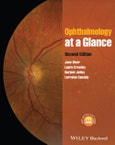Ophthalmology at a Glance provides a concise overview of the specialty, with clear and simple diagrams illustrating the essential information required for students, trainee optometrists, opticians and specialty nurses.
It includes details on history and examination, before moving through specific conditions and their treatment. Closely tracking the undergraduate ophthalmology curriculum, this new edition is fully updated to reflect new developments in the field.
Table of Contents
Preface to second edition 7
Preface to first edition 7
Acknowledgements 7
Contributors 8
How to use your textbook 9
About the companion website 13
Part 1 Principles of ophthalmology
1 Introduction: what is ophthalmology? 14
2 Medical student aims 16
3 Social and occupational aspects of vision 18
Part 2 Ophthalmic history and examination
4 Taking the history and recording the findings 20
5 Visual acuity in adults 22
6 Examination of visual fields 24
7 Other visual functions 26
Part 3 Correction of refractive errors
8 Basic optics and refraction 28
9 Glasses, contact lenses and low-vision aids 30
Part 4 Basic eye examination
10 External eye and anterior segment 32
11 Posterior segment and retina 34
12 Use of eye drops 36
Part 5 Acute ophthalmology
13 Red eye: the conjunctiva 38
14 Red eye: the cornea 40
15 Red eye: the sclera and episclera 42
16 Ophthalmic trauma principles and management of chemical injuries 44
17 Specific features of blunt and sharp injuries 46
18 Loss of vision in the inflamed eye 48
19 Sudden painful loss of vision in a non-inflamed eye 50
20 Sudden painless loss of vision 52
Part 6 Gradual loss of vision
21 Gradual loss of vision 55
Part 7 Sub-specialty - Paediatric ophthalmology
22 Visual acuity in children 58
23 Strabismus (squints) 60
24 Neonates 62
25 Infants and older children 64
Part 8 Sub-specialty - Eyelid, lacrimation and orbit
26 Common eyelid lumps 66
27 Common eyelid malpositions 68
28 Lacrimation (tearing) 70
29 Basic orbital assessment 72
30 Orbit disease, thyroid eye disease and facial palsy 74
31 Ocular oncology 76
Part 9 Sub-specialty - External eye disease
32 Common conditions affecting the external eye 78
33 Common conditions affecting the cornea 81
34 Medical uses of contact lenses 84
Part 10 Sub-specialty - Corneal, refractive and cataract surgery
35 Corneal and laser refractive surgery 86
36 Cataract assessment 89
37 Cataract surgery 92
38 Cataract surgery postoperative care 94
Part 11 Sub-specialty - Glaucoma
39 Glaucoma: the basics 96
40 Detecting glaucoma 98
41 Medical and surgical treatment of glaucoma 100
Part 12 Sub-specialty - Vitreo-retinal
42 Retinal detachment 102
43 Retinal and choroidal anatomy and imaging 104
44 Inherited retinal disorders and age-related macular degeneration 106
45 Diabetic retinopathy classifi cation and typical lesions 108
46 Diabetic retinopathy treatment 110
47 Retinal artery obstruction 112
48 Retinal vein occlusion 114
49 HIV infection and AIDS 117
50 Tropical ophthalmology: tropical eye disease 120
51 Tropical ophthalmology: global eye health 122
Part 13 Sub-specialty - Neuro-ophthalmology
52 Pupil abnormalities 124
53 Optic nerve disease 126
54 Cranial nerve palsies and eye movement disorders 128
55 Visual fi eld defects 130
56 Giant cell arteritis 132
Appendix 1: Red eye - signs and symptoms of different causes 134
Appendix 2: The layers of the retina 135
Appendix 3: Pharmacological intraocular pressure (IOP)- lowering agents - mechanism of action and side effects 136
Appendix 4: Optical coherence tomography (OCT) reports 137
Appendix 5: Important clinical trials in AMD 138
Index 139








